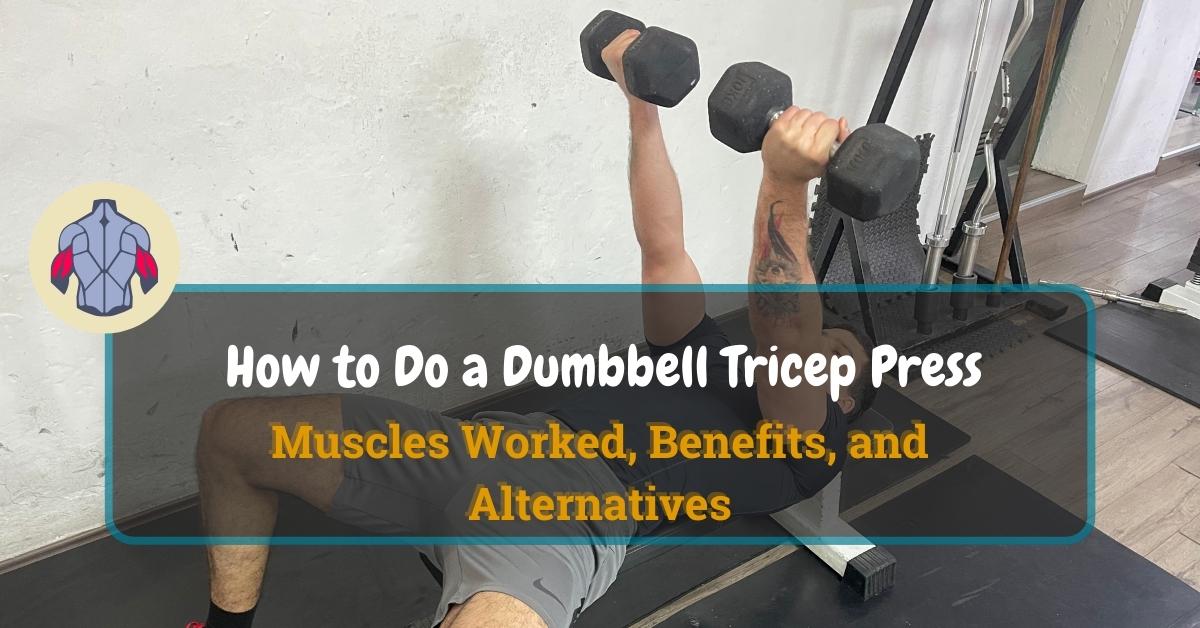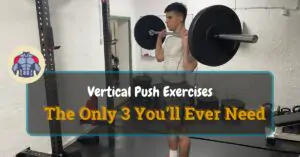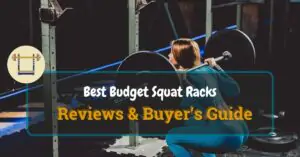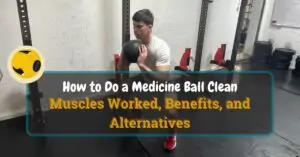The dumbbell tricep press is a unique modification of the dumbbell bench press exercise that will isolate your tricep heads much better. It is also very functional in nature and one of the reasons why I always incorporate it into my own and clients’ workout routines.
Table of Contents
ToggleHowever, there is a specific way to perform the dumbbell tricep press to get the most out of your tricep hypertrophy efforts. You must follow the dumbbell tricep press form guidelines I outline below to build strong and big arms.
Here is what you can expect to learn about in the sections below:
- The step-by-step process to execute the dumbbell tricep press with precision.
- Insights into the muscles activated during this exercise and the plethora of benefits it bestows.
- Variations and alternatives to the classic tricep press to enhance your workout diversity and address different fitness levels.
Let’s start by mastering the proper form and technique of the dumbbell tricep press.
Start Building Your Dream Body Today
Ready to elevate your fitness game without falling into the trap of dull, repetitive routines that just don’t deliver? Imagine sculpting your ideal physique and boosting your health, all while still enjoying life’s pleasures, like those irresistible weekend getaways and your aunt’s legendary cheesecake. With our online fitness and nutrition coaching service, you don’t have to compromise. Dive into a personalized fitness journey that blends perfectly with your lifestyle, not against it. Book your completely free discovery consultation today, and take the first step towards a transformation that doesn’t require giving up the joys of life.

“I was skeptical about online fitness coaching, but Functional Body Savage completely changed my perspective. Vanja and Radomir’s personalized approach and attention to detail have helped me achieve goals I never thought possible. I’m stronger, more confident, and grateful for their guidance.”
Emily Thompson, San Francisco, CA
Learn More About Our Online Coaching ServiceQuick Summary
- To perform a dumbbell tricep press, lie on a flat bench, hold dumbbells with a supinated grip outside your chest, press them towards the ceiling, and then lower back to start.
- Alternatives like the rope cable tricep extension and single dumbbell overhead extension can enhance workout variety and tricep engagement.
- The study “Loading Recommendations for Muscle Strength, Hypertrophy, and Local Endurance” suggests using a moderate load (60%-80% of 1RM) for 8-12 reps to optimize hypertrophy.
- In my experience, balancing heavy and lighter exercises in tricep workouts is crucial for muscle growth and endurance, reflecting best practices in strength training.
How to Do a Dumbbell Tricep Press
The dumbbell tricep press, a slightly different dumbbell bench press variation, isolates your triceps for targeted muscle growth and strength. To ensure you’re getting the most out of this exercise, follow these detailed steps.
Step One — Lie on the Flat Bench on Your Back
Grab two dumbbells of appropriate weight so you can perform between 8-12 consecutive reps without stopping. Assume a lying position on your back on the flat bench. Hold both dumbbells with the supinated grip just outside your body at the chest level.
Imagine doing a dumbbell bench press with a supinated grip, but your hands are much closer to your body. Basically, the angle between your upper arm and body is the smallest possible.
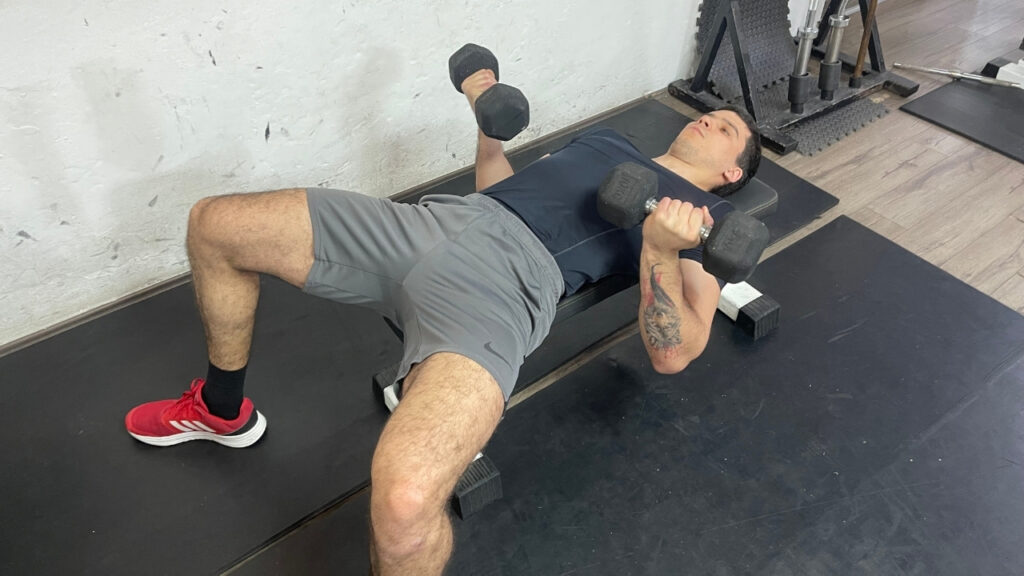
Pro Tip: Place your arms as close to the body as possible. If we access this movement on a biomechanical basis, we can quickly understand that the closer the arms are to the body, the more the tricep works compared to the chest muscles. This is simply because tricep muscles are responsible for extension in the sagittal plane, and chest muscles work more in the transverse plane.
Step Two — Press the Dumbbells Towards the Ceiling
Quickly press the dumbbells towards the ceiling. Don’t overextend your elbows since that will lead to tricep relaxation. Just before you fully extend the elbow, stop pushing the dumbbells upwards. Hold the top position for one second before proceeding with the next step.
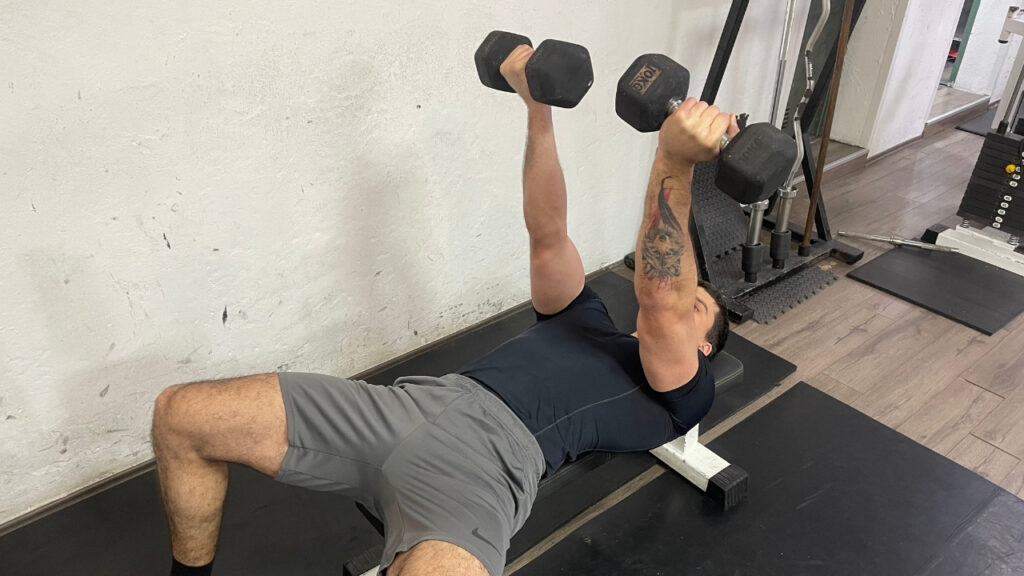
Pro Tip: Focus on pushing the dumbbells only in the sagittal plane. This means you should avoid adduction with your shoulders since that leads to greater chest muscle activation.
Step Three — Lower the Dumbbells to the Starting Position
Slowly lower the dumbbells to the starting position. Avoid dropping the dumbbells towards your chest since that will also relax your triceps and prevent desirable muscle hypertrophy effects. Focus on the lowering part of the lift to increase the overall intensity, time under tension (TUT), and mind-muscle connection.
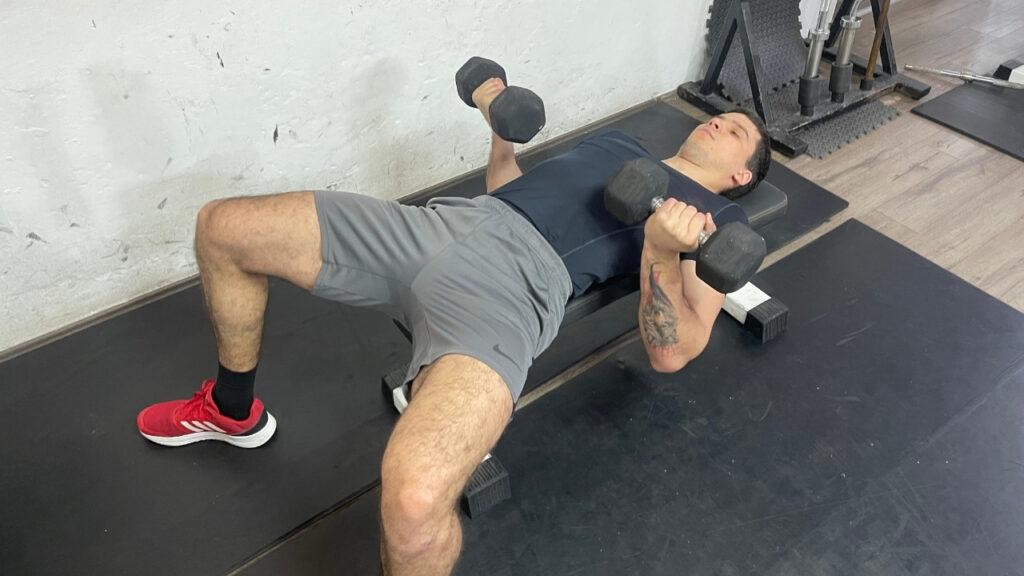
Pro Tip: In my experience, I found the three-second lowering phase to be the most effective when it comes to muscle hypertrophy. You will also master the form and technique and learn how to control weights to avoid injuries and maximize performance properly.
Dumbbell Tricep Press Muscles Worked
The primary muscle working during the dumbbell tricep press is the tricep brachii.
Secondary muscles include deltoids, pectoralis major, and core muscles.
Dumbbell Tricep Press Benefits
Here are the most important dumbbell tricep press benefits you should be aware of.

Exercising Your Tricep Through the Compound Movement
With this supinated dumbbell press variation, you can easily target the growth of your triceps brachii through the compound movement. What do I mean by that? Well, the supinated press is indeed a compound exercise because it requires your elbows, shoulders, and shoulder blades to work simultaneously to execute the movement.
This allows you to target your triceps through a more functional compound movement than solely relying on isolation exercises.
Developing Shoulder Stability Along the Way
One added benefit that comes with this tricep press variation is you will effectively strengthen your shoulder stabilizers. This is simply because of the nature of free weights and how they challenge your whole body’s stability.
Improving Core Stability
Core stability will also be improved because you are required to keep your body balanced throughout the entire tricep press movement. Also, if you want to challenge your core muscles even more, try lifting your feet off the floor. This will force your core muscles to work harder since the feet are no longer in the equation in terms of providing stability.
Adding More Versatility to Your Tricep Workouts
Let’s face it: doing rope tricep extensions and skull crushers quickly becomes dull. To get the most out of your tricep workout routine, you must emphasize exercise versatility and aim to incorporate movements you didn’t do before.
At least, you should focus on always changing the stimuli you are adapting to. That is one of the very first principles of strength and hypertrophy training.
My professor of antropomotorics once said: “Strength loves diversity”.
Tips
Here are the best tips to follow when doing dumbbell tricep presses.
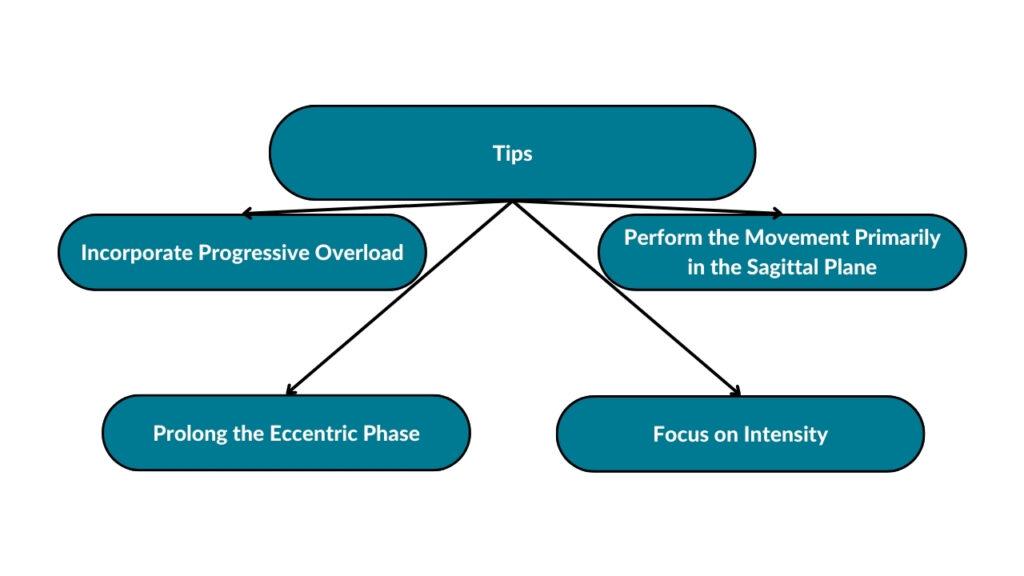
Incorporate Progressive Overload
Incorporating the principles of progressive overload is the very first thing to do if you want to progress in terms of strength and hypertrophy. If you fail to increase the external load, reps, sets, and training frequency or fail to select different exercises for the following workouts, you will likely fail.
Shortening rest periods between the sets also works, but not always. In the case of strength and power, shortening rest intervals will likely reduce your performance.
According to the study from PubMed Central titled “Loading Recommendations for Muscle Strength, Hypertrophy, and Local Endurance,” a low repetition scheme with heavy loads (from 1 to 5 repetitions per set with 80% to 100% of 1-repetition maximum (1RM)) optimizes strength increases.
Also, a moderate repetition scheme with moderate loads (from 8 to 12 repetitions per set with 60% to 80% of 1RM) optimizes hypertrophic gains [1].
Prolong the Eccentric Phase
Prolonging the eccentric phase can help you increase the time your muscles are under tension and trigger signals that lead to muscle growth. Also, you can focus more on intensity and mastering proper form and technique.
You will also feel the burning sensation in your muscles more, which is rarely a bad sign. Only if you overtrain can this turn out to be bad.
Focus on Intensity
Focusing on intensity is crucial for strength and muscle hypertrophy. If you don’t push yourself constantly over your limits, you will likely fail to keep growing and improving. The trick is to step out of your comfort zone every single time you visit the gym. However, you must do it in a way that avoids getting injured and keeps your motivation levels constant.
Ask yourself:
What more can I do today to improve but not decrease my current motivation and lose the will to live afterward?
Sounds harsh, but it helps with gauging proper intensity and progression for each following workout.
Perform the Movement Primarily in the Sagittal Plane
The reason why you should perform the dumbbell tricep press primarily in the sagittal plane is because the tricep is responsible for elbow extension. Elbow extension occurs in the sagittal plane.
However, the chest is a complex muscle that can trick you by lending its strength and forcing you to move from the sagittal to the transverse plane. This is when you start doing traditional and not specific tricep presses. This is also why I always advise keeping your arms as close to the body as possible and following a straight trajectory on the way up and down.
Most Common Mistakes
Here are the most common mistakes during dumbbell triceps presses.
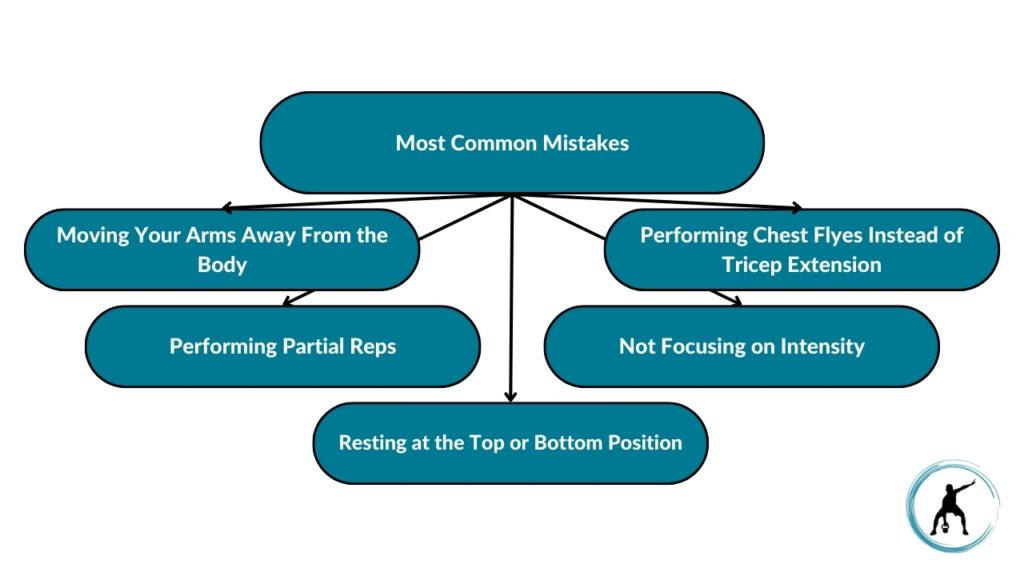
Moving Your Arms Away From the Body
By moving your arms away from the body, you risk activating your chest muscles more. Keep your arms close to the body and think consciously about it throughout the entire movement to isolate your tricep muscles.
Performing Partial Reps
Partial reps are almost always a no-go. However, I do think there is a time and place for partial reps. For example, let’s assume you want to train to failure. You perform 10 normal reps with a complete range of motion.
Suddenly, you feel your muscles burning and know you won’t be able to perform the next rep with the full range of motion. Only in that case do I support the use of partial reps just to get the most out of the single working set.
Resting at the Top or Bottom Position
Don’t rest at the top or bottom position. This will allow your tricep muscles to relax and prevent you from getting the maximum in terms of muscle hypertrophy and strength gains.
Not Focusing on Intensity
Failing to focus on the sole intensity of the exercise can result in undesirable results in terms of muscle strength and hypertrophy. You should focus on proper intensity with each workout, set, and rep if you wish to improve your muscle-gaining capabilities along with your strength gains.
Performing Chest Flyes Instead of Tricep Extension
This primarily boils down to performing the dumbbell tricep press movement more in the transverse and not the sagittal plane of motion. To fix this, focus on elbows and shoulder flexion and extension and prevent shoulder adduction and abduction. Focus on moving the weight only in one plane, which is the sagittal plane.
Dumbbell Tricep Press Variations
Below are some of the best dumbbell tricep press variations to consider adding to your workout routine.
Alternating Dumbbell Tricep Press
Essentially, the alternating dumbbell tricep press variation adds a little versatility and stability component to the entire exercise.
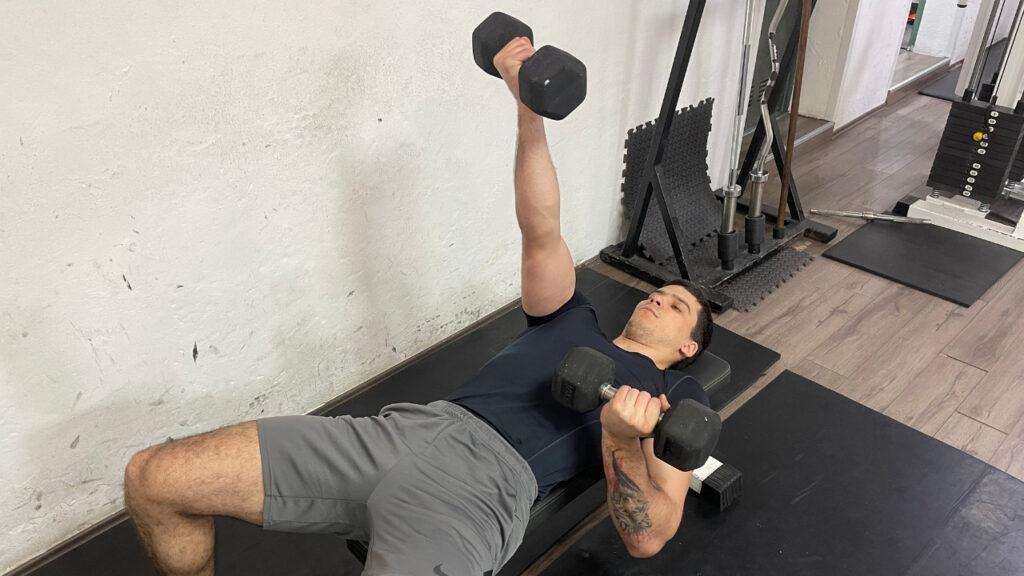
Steps:
- Pick two dumbbells of appropriate weight and lie on the flat bench on your back.
- Assume the same starting position as for the regular dumbbell tricep press variation.
- Only this time, lower one dumbbell at a time and begin lowering the second one only after you complete the entire rep with the first.
Pro Tip: Squeeze your core and hip muscles to allow for better stability during the exercise. Abdominal breathing during the concentric phase can also help stabilize the body and perform the movement more easily.
Single Dumbbell Tricep Press
The single dumbbell tricep press is a great unilateral tricep variation where you can also improve your core stability and activity of stabilizer muscles.
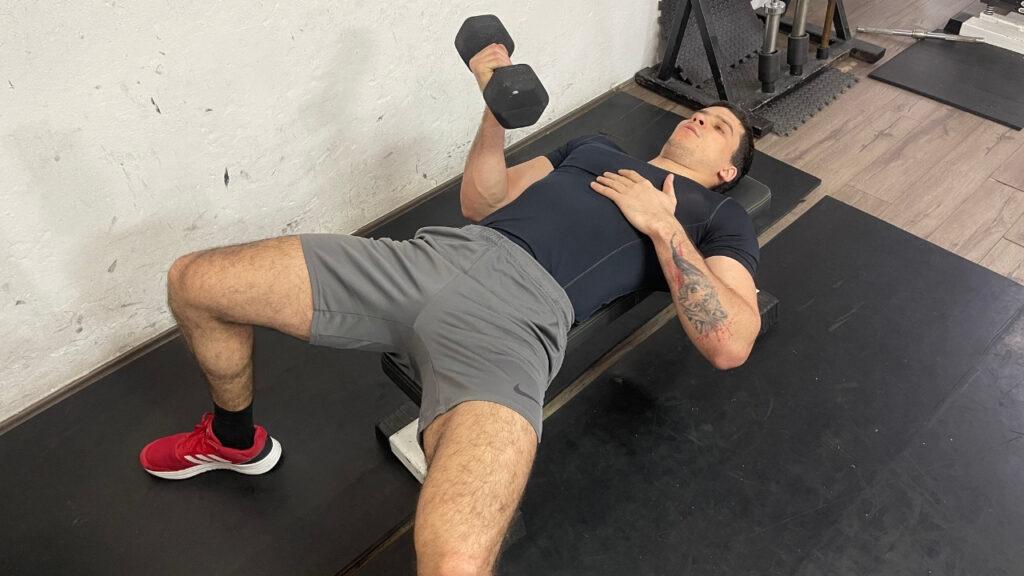
Steps:
- Pick one dumbbell of appropriate weight and assume the same starting position as with the original bilateral variation.
- Slowly lower the dumbbell towards the ground while contracting your core and hip muscles to remain stabilized.
- Push the dumbbell towards the ceiling and repeat for the desired number of reps.
Pro Tip: Contract your leg, hip, and core muscles throughout the entire movement to ensure stability and balance.
Incline Dumbbell Tricep Press
The incline dumbbell tricep press effectively targets the same muscles under a different angle.
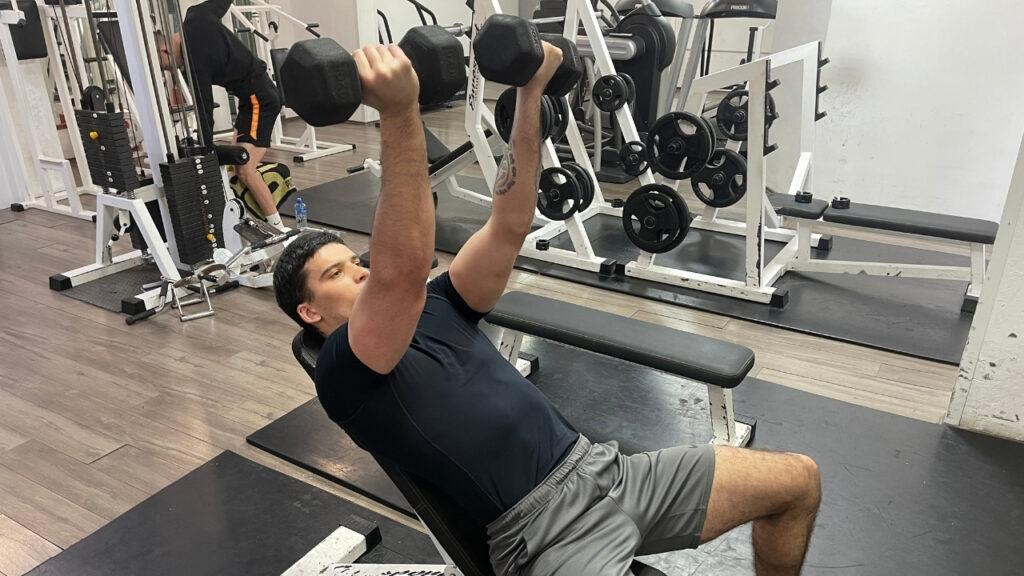
Steps:
- Set the incline between 30 and 45 degrees and lie on the bench on your back.
- Perform the same movement as with the regular dumbbell tricep press, just on the new incline setting.
Pro Tip: Change the angle of the incline for each following workout to target and activate primary and secondary muscles differently during the dumbbell tricep press movement.
Dumbbell Tricep Press Alternatives
Here are the best dumbbell tricep press alternatives to consider.
Rope Cable Tricep Extension
The rope cable tricep extension is a versatile exercise that targets the triceps by using a cable machine and a rope attachment, allowing for a range of motion that deeply engages the tricep muscles.
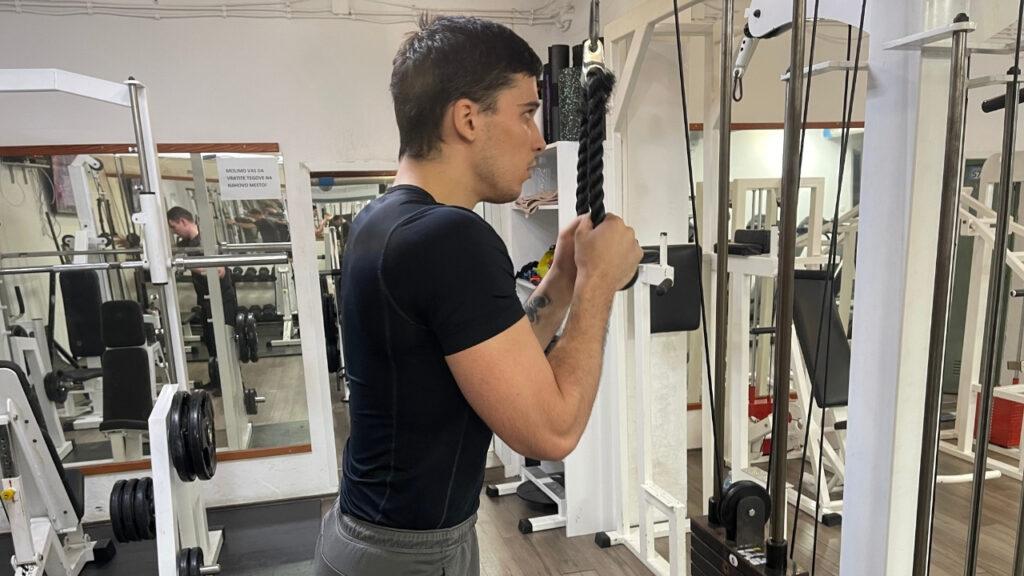
Step-by-Step Guide:
- Attach a rope to a high pulley of a cable machine.
- Grasp the rope with both hands and face away from the machine, elbows bent and close to your body.
- Extend your arms fully downwards, separating the rope ends as you finish the movement.
- Pause briefly at the bottom, then slowly return to the starting position.
Pro Tip: Rotate your wrists outward as you extend your arms to emphasize the tricep contraction, enhancing muscle engagement and growth.
Single Dumbbell Overhead Tricep Extension
This exercise isolates the triceps by extending a dumbbell overhead with a single hand, offering an effective way to build strength and definition in the upper arms.
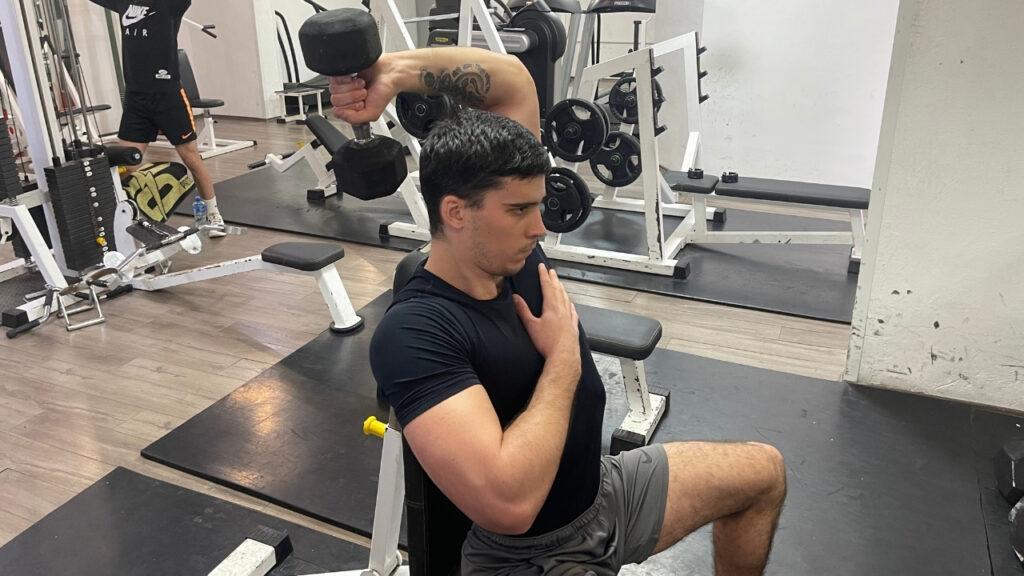
Step-by-Step Guide:
- Stand with feet shoulder-width apart, holding a dumbbell with one of your hands overhead.
- Keeping your elbow pointing forward, lower the dumbbell behind your head by bending your elbows.
- Extend your arm to lift the dumbbell back to the starting position.
- Keep your core engaged and back straight throughout the movement.
Pro Tip: Focus on keeping your elbow stationary and only moving your forearm, as this ensures the tricep is fully engaged and maximizes the effectiveness of the exercise.
Skull Crushers
Skull crushers, also known as lying tricep extensions, involve lowering a weight towards your forehead while lying on a bench, making it a staple exercise for tricep development.
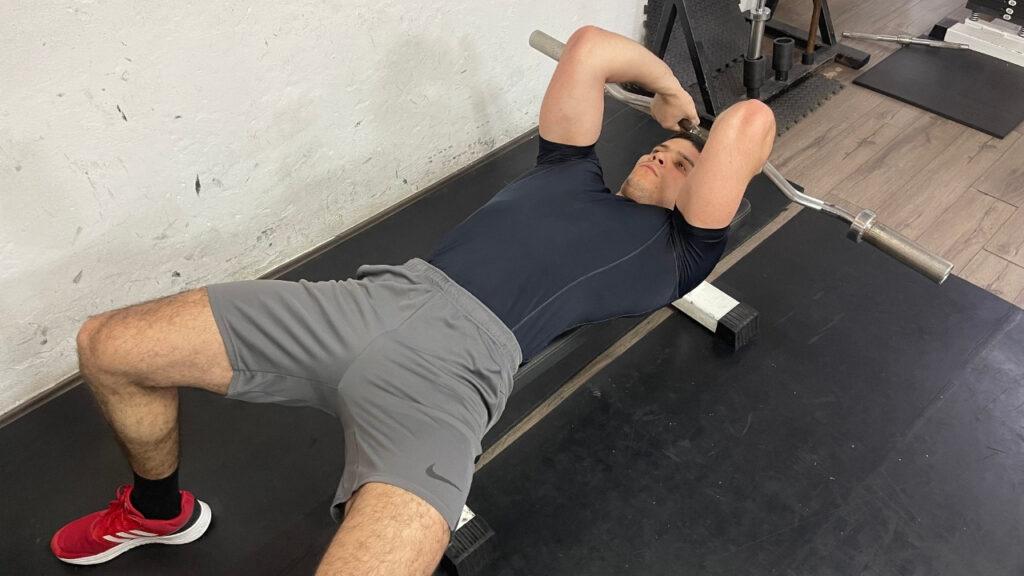
Step-by-Step Guide:
- Lie on a flat bench with an EZ bar in your hands, arms extended straight up over your shoulders.
- Slowly bend your elbows to lower the EZ bar towards your forehead, keeping your upper arms stationary.
- Extend your arms back to the starting position, focusing on using your triceps to move the weight.
- Maintain a controlled motion and avoid letting the Ez bar drift too far back.
Pro Tip: To avoid elbow strain and increase tricep activation, keep the movement slow and controlled, and consider slightly angling your arms backward instead of straight up.
FAQs
Are Dumbbell Presses Good for Triceps?
Dumbbell presses are good for the triceps, as they engage the triceps muscles during the pressing motion. This exercise requires the triceps to work in concert with the chest and shoulders, making it a comprehensive upper-body workout that enhances tricep strength and size.
How Can I Do Tricep Press at Home?
You can do a tricep press at home by using a pair of dumbbells or any weighted object that can be safely held in both hands. Lie on your back on the floor or a bench, hold the weight above your chest with straight arms, then lower it towards your chest by bending your elbows before pushing it back up.
How to Build Triceps Fast?
To build triceps fast, focus on exercises that specifically target the triceps muscle group with high intensity, such as close-grip bench presses, dips, and overhead tricep extensions. Consistency, progressive overload, and adequate rest and nutrition are key factors in stimulating tricep growth effectively and rapidly.
What Is the Number 1 Tricep Exercise?
The number 1 tricep exercise is often considered to be the close-grip bench press because it allows for heavy weights to be used while targeting the triceps extensively. This exercise not only engages the triceps effectively but also incorporates the chest and shoulders, making it a powerful move for overall upper-body strength.
Should You Go Heavy on Triceps?
Going heavy on the triceps can be beneficial for building strength and muscle mass, but it’s important to balance heavy weights with proper form to prevent injury. It’s advisable to include both heavy and lighter, high-repetition exercises in your triceps routine to promote muscle growth and endurance without compromising joint health.
Wrapping Up
Mastering the dumbbell tricep press can significantly enhance your upper-body routine by isolating and building the triceps effectively. By adhering to the precise form guidelines provided, you’ll unlock the potential for stronger, larger arms while reaping the benefits of improved muscle activation and workout versatility.
Whether you’re incorporating classic presses or exploring alternatives, the key lies in consistency, proper technique, and a willingness to challenge your muscles with diverse exercises, ensuring continuous growth and strength development.
This guide not only equips you with the knowledge to execute the dumbbell tricep press correctly but also encourages you to diversify your approach to tricep training for optimal results.
Start Building Your Dream Body Today
Ready to elevate your fitness game without falling into the trap of dull, repetitive routines that just don’t deliver? Imagine sculpting your ideal physique and boosting your health, all while still enjoying life’s pleasures, like those irresistible weekend getaways and your aunt’s legendary cheesecake. With our online fitness and nutrition coaching service, you don’t have to compromise. Dive into a personalized fitness journey that blends perfectly with your lifestyle, not against it. Book your completely free discovery consultation today, and take the first step towards a transformation that doesn’t require giving up the joys of life.

“I was skeptical about online fitness coaching, but Functional Body Savage completely changed my perspective. Vanja and Radomir’s personalized approach and attention to detail have helped me achieve goals I never thought possible. I’m stronger, more confident, and grateful for their guidance.”
Emily Thompson, San Francisco, CA
Learn More About Our Online Coaching ServiceReferences:
- Schoenfeld BJ, Grgic J, Van Every DW, Plotkin DL. Loading Recommendations for Muscle Strength, Hypertrophy, and Local Endurance: A Re-Examination of the Repetition Continuum. Sports (Basel). 2021;9(2):32. Published 2021 Feb 22. doi:10.3390/sports9020032

